AMD’s Radeon HD 6870 & 6850: Renewing Competition in the Mid-Range Market
by Ryan Smith on October 21, 2010 10:08 PM ESTLast but not least in our look at AMD’s new Radeon 6800 series is our look at power consumption, GPU temperatures, and the amount of noise generated. With efficiency being one of the major design goals for Barts, AMD stands to gain a lot of ground here compared to the 5800 series for only a minor drop in performance.
Looking quickly at the voltages of the 6800 series, we have 4 samples – 2 each of the 6870, and 2 each of the 6850. Both of our 6870 cards have an idle voltage of 0.945v and a load voltage of 1.172v, and seeing as how they’re both based on AMD’s reference design this is what we would expect for a design that is based around a single VID.
However our 6850 results, which include a non-reference card in the form of XFX’s customized 6850, are much more interesting. While our reference 6850 has a load voltage of 1.094v, our XFX card reports a load voltage of 1.148v. We’ll be taking a look at the XFX 6850 in-depth next week in our 6850 roundup, but for now this leaves us with the question of whether AMD is using variable VIDs, or if XFX is purposely setting theirs higher for overclocking purposes.
| Radeon HD 6800 Series Load Voltage | |||||
| Ref 6870 | XFX 6870 | Ref 6850 | XFX 6850 | ||
| 1.172v | 1.172v | 1.094v | 1.148v | ||
Finally our EVGA GTX 460 1GB FTW card has a VID of 0.975v, which compared to all the other GTX 460 cards we’ve tested thus far makes it quite notable. This is lower than any of those other cards by 0.012v, a property we believe is necessary to sell such a heavily overclocked card without causing a similarly large rise in power/heat/noise. It’s also for this reason that we question whether NVIDIA could actually supply suitable GF104 GPUs in high volumes, as GPUs capable of running at this voltage are likely coming from the cream of the crop for NVIDIA.
For our tests, please note that we do not have a pair of reference 6850s. For our second 6850 we are using XFX’s customized 6850 card, which means our results will undoubtedly differ from what a pair of true reference cards would do. However as the 6850 reference design will not be widely available this is less important than it sounds.
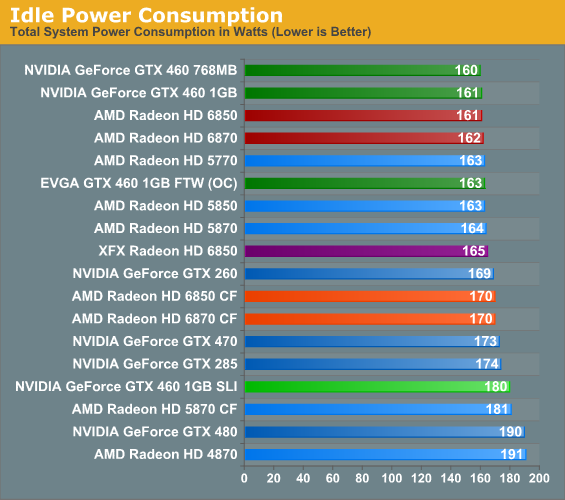
As always we start our look at power/temp/noise with our look at idle power. Because we use a 1200W PSU in our GPU test rig our PSU efficiency at idle is quite low, leading to the suppression of the actual difference between cards. But even with this kind of suppression it’s still possible to pick out what cards have a lower idle power draw, as the best cards will still result in a total system power draw that’s at least a couple of watts lower.
AMD’s official specs call for the 6800 series to have a lower idle power draw than the 5800 series, and while we can’t account for all 8 watts we do manage to shave a couple of watts off compared to our 5800 series cards. The Crossfire results are even more impressive, with the 6870CF drawing 11W less than the 5870CF.
Compared to the 6800 series the GeForce GTX 460 768MB does manage to hang on to top honor here for a single card by a watt, however in SLI our 1GB cards do worse than our 6800 series cards by 10W.
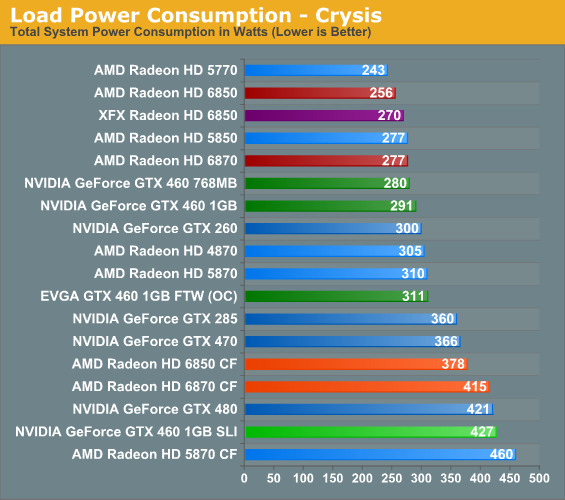
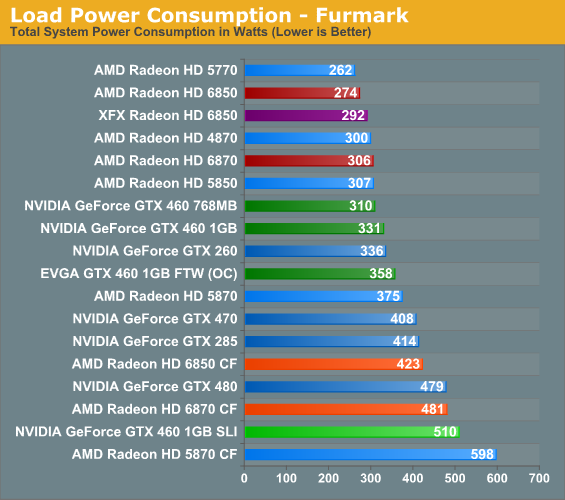
Looking at load power consumption it’s clear from the start that AMD’s efficiency gains are going to pay off here. On the latest iteration of our power consumption chart the 6850 underconsumes even the already conservative 5850 by 20W under Crysis and 25W under FurMark, showcasing how AMD was able to reduce their power consumption by a significant amount while giving up much less in the way of performance.
Compared to the 6800 series NVIDIA does notably worse here, with all of the GTX 460 cards pulling down more power than the 6870 and the GTX 470 being in a league of its own. While NVIDIA was competitive with Cypress on power, they’re not in a position to match Barts. They can deliver Barts-like performance (and then some), but they have to consume more power to do it.
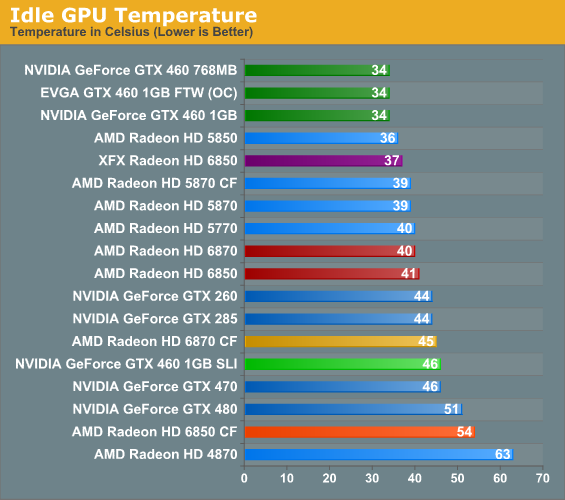
Up next is our look at GPU temperatures, starting with idle temps. As we mentioned in our GTX 460 review, NVIDIA ended up producing a very effective reference cooler for the GTX 460, utilizing an open-air design that by dissipating air inside and outside of the case is capable of reaching temperatures fully exhausting coolers can’t match. As a result all of the GTX 460 cards top our charts here.
Prior to the GTX 460 series this is a metric the 5850 always did well in, so we had expected a similar performance from the 6850, only to leave disappointed. What we’re ultimately looking at is a matter of the quality of the cooler: the 6850 may consume less power than the 5850 at idle, but it packs a weaker cooler overall, allowing it to approach these temperatures. For a gaming card such as the 6800 series idle temperatures are almost entirely superficial once we get below 50C, but even so this tells us something about the 6850 reference cooler.
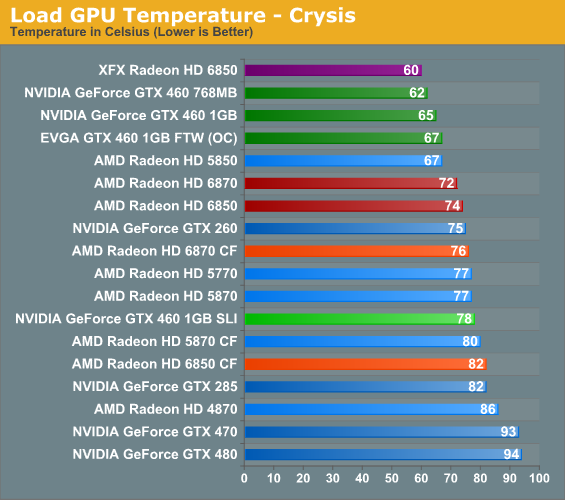
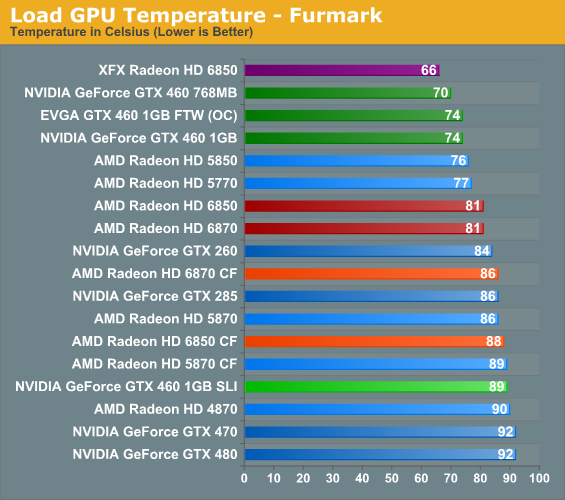
Thanks to the GTX 460’s open-air cooler, all of our GTX 460 cards top our temperature chart even with their higher power consumption. The trade-off is that all of these cards require a well-ventilated case, while the Radeon 5800 and 6800 series will tolerate much poorer cases so long as there’s enough ventilation for the card to pull in air in the first place.
As was the case with idle temperatures, the reference 6850 ends up doing worse than the 5850 here thanks to its less effective cooler; however the 6870 ends up doing better than both the 6850 and 5870 due to its more effective cooler and its lower power consumption compared to the 5870. While these cards can’t quite touch the GTX 460 series, we’re still looking at some of the coolest cards among our current benchmark suite.
Meanwhile our XFX 6850 ends up doing the best out of all of our cards here, however this will come at a cost of more noise. We'll touch on this more next week in our 6850 roundup.
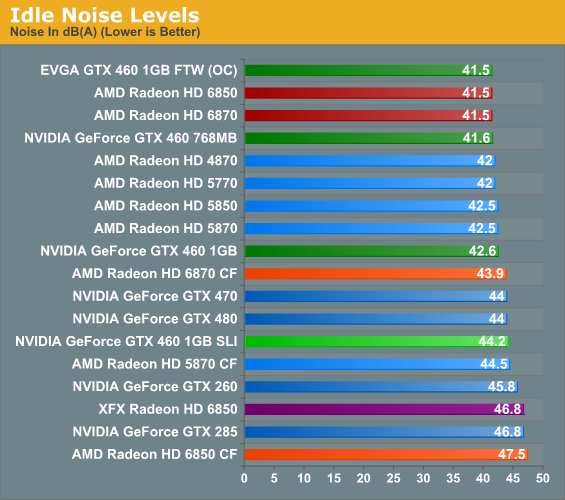
Last but not least is idle noise, which isn’t much of a story with modern cards. With the exception of the GTX 470/480, the latest GeForce and Radeon cards are both capable of running up against the noise floor of our testing environment.
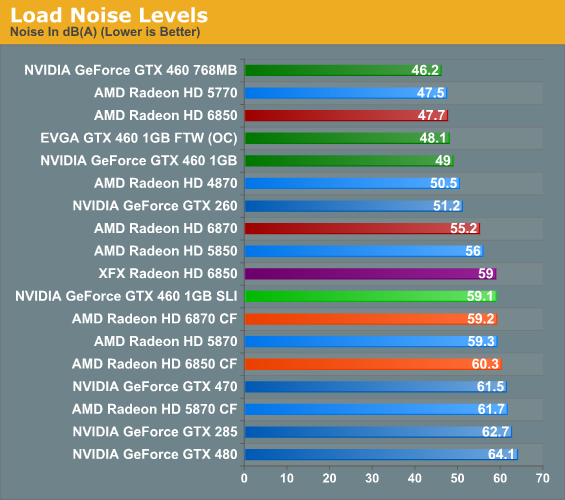
Under load we once again see an NVIDIA GTX 460 card top the chart thanks to its open-air design. This is followed very closely however by the Radeon 6850, which at 47.7dB is our third-quietest card and finally showing off the advantages of the tradeoffs AMD made with the reference cooler. The 6850 may not be as cool as the 5850, but it’s quite a bit quieter. As for the XFX card, this is where XFX has to pay the piper, as their 6850 card ends up being as loud as a 5870 in exchange for their lower temperatures.
Meanwhile the 6870 ends up being quite a bit louder than both the GTX 460 series and the 6850, coming in at 55.2dB. This is a definite leg-up compared to the 5870 and nicely cements the fact that the 6870 is intended to be the 5850’s replacement, but it means the GTX 460 series spoils the results here. Once custom-design vendor cards come out for the 6870, I suspect we’re going to see someone quickly sell a 6870 with a less aggressive cooler, which for the costs of higher temperatures would afford less noise.










197 Comments
View All Comments
Ryan Smith - Friday, October 22, 2010 - link
Quality is unchanged. UVD 3 adds a few fixed function blocks, but quality is a matter of post-processing and hence affected by the drivers once you have sufficient shader power to do all the post-processing.Pastuch - Friday, October 22, 2010 - link
I posted about this earlier but my post was deleted.Ryan there is a ton of HTPC users on this site.
1. Exactly how long is the Radeon 6870/6850 vs the GTX 460?
2. How does the GTX460 compare to the Radeon 6 series regarding bitstreaming high def audio?
3. How UVD3 post-processing compare to Nvidias?
Ryan Smith - Friday, October 22, 2010 - link
It's exactly the same as this: http://www.anandtech.com/show/3973/nvidias-geforce...HigherGround - Friday, October 22, 2010 - link
Why was EVGA card included in this test? The rest of the field is generic (non OC, no brand), so why included an OC card, which skews the readers perspective? Pretty sure EVGA paid you to included its top OC card in this review ...Parhel - Friday, October 22, 2010 - link
No, NVidia paid them to include it. NVidia sends "guidelines" to all the hardware review sites, telling them what settings to use and which cards to use in the comparison. In the guidelines for today's review was to use the EVGA GTX 460 FTW, and and site you see using it is essentially a paid NVidia shill.I could care less about ATI vs NVidia, as I'm not really a gamer, but I'm very disappointed today to see my long time favorite hardware site stooping to this level. In the end, it gives consumers bad information, which should be antithetical to the purpose of a site like this.
AtwaterFS - Friday, October 22, 2010 - link
I agree, this site is typically class-leading, but this article give AnandTech a bit of a black eye and the results dont particularly jive with "un-biased" sites like HardOCP.DrKlahn - Friday, October 22, 2010 - link
I was going to post the same thing. As a long time reader of this site, I was very disappointed with the decision to include the overclocked card. Either the ATI cards should have been overclocked and their results provided in every test or it should have been excluded as per the normal benchmarking guidelines.I would have no issue with a followup or side article comparing factory overclocked offerings. But this is clearly bowing to pressure from Nvidia and I expected better of this site.
aungee - Saturday, October 23, 2010 - link
To Include the EVGA GTX 460 FTW was unfair and whether intentional or not it did spoil the launch party for AMD on this site to some degree. It would have been more appropriate to make a small mention of it's existence and to benchmark it in the future against any factory OC 6800 cards.After getting your head around the naming, AMD needs to be credited for bringing such a performance on only a 255 mm2 package (it even caused the price drop for the 530mm2 GTX 470) . AMD has headroom to drop the price of the 6800 cards so lets hope they do soon.
tigersty1e - Friday, October 22, 2010 - link
I couldn't find the clocks, but if you do include an OC'd card in your benches, you should give us the clocks.dertechie - Friday, October 22, 2010 - link
850 MHz Core, 1700 MHz shaders, 4 GHz Memory, up from 675 MHz Core, 1350 MHz shaders, 3.6 GHz Memory.That's a 26% Core OC and an 11% Memory OC. However, the cost has been OC'd too, the FTW card costs the same $240 as the stock Radeon 6870.